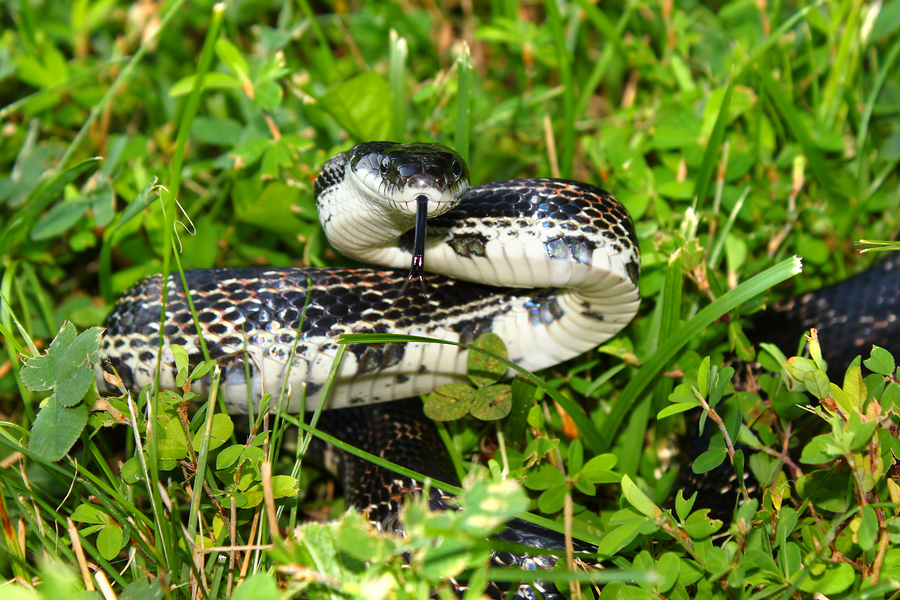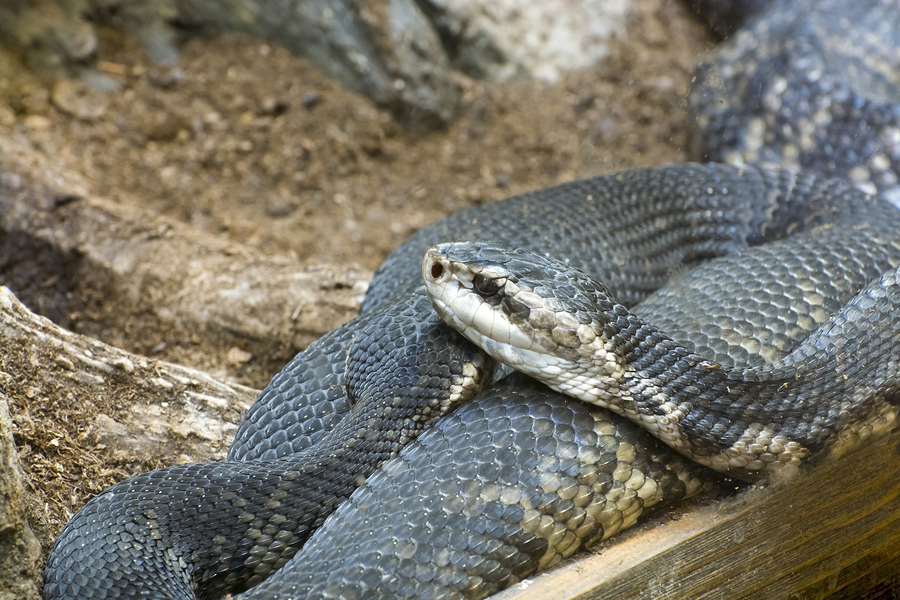
Apr 19, 2017 | Wildlife
Common Snakes in the South: Identification, Threats & Snake Control Tips
Eastern Kingsnakes

What do they look like?
- Large snakes, usually 3-4 feet long
- Shiny black color with white or yellow bands
- Short, blunt snout and rectangular looking head
- Small beady eyes
Where do you find them?
- Protected areas such as woods, overgrown vegetation, cluttered areas, etc.
- Prevalent throughout the southeast U.S.
- Most active during summer months in the morning hours
How dangerous are they?
- Strong constrictors
- Non-venomous
- May bite if handled or threatened
How do you prevent and/or control them?
- Keep food sources away from your home – other snakes, lizards, rodents, and birds
- Limit clutter and stored wood near your home
- Use a product that snakes find repellent to prevent them
- Professional snake control by a licensed pest control company
Rat Snakes

What do they look like?
- Large snakes, 3-6+ feet long
- Black, yellow with stripes, or gray with darker patches
Where do you find them?
- Semi-protected areas such as woods, over grown vegetation, swamps, abandoned or vacant buildings, etc.
- Prevalent throughout the southeast U.S.
How dangerous are they?
- Non-venomous
- May bite if handled or threatened
- May climb for food
How do you prevent and/or control them?
- Keep food sources away from your home – rats, mice, squirrels, birds, and bird eggs
- Use a product that snakes find repellent to prevent them
- Professional snake control by a licensed pest control company
Garter Snakes

What do they look like?
- Small to medium sized snakes, 1.5-4 feet long
- Three yellow stripes running vertically down a dark colored body
Where do you find them?
- Protected areas such as woods and marshes, but are also very common in grassy areas and around water
- Suburban areas where areas of cover/shelter are available
- Active day or night and often found under boards or debris
- Common throughout the southeast and most of the U.S.
How dangerous are they?
- Non-venomous
- May bite if handled or threatened
How do you prevent and/or control them?
- Keep food sources away from your home – worms, slugs, frogs, toads, salamanders, fish and tadpoles
- Limit items that can be used as cover/shelter around the home like scraps pieces of wood and debris
- Use a product that snakes find repellent to prevent them
- Professional snake control by a licensed pest control company
Black Racer Snakes

What do they look like?
- Large snakes, 5+ feet long
- Slender, solid black color and may have a white chin
- Often confused for other large, black snakes
- Juveniles look very different from adults; they are grayish colored with darker blotches
Where do you find them?
- Thrive in nearly any habitat, but are more abundant near forest edges, old fields, or wetland edges
- Common throughout the eastern U.S.
- Active during warmer months in the daytime hours
How dangerous are they?
- Usually flee from threats
- Non-venomous
- May bite if handled or threatened
How do you prevent and/or control them?
- Keep food sources away from your home – insects, lizards, snakes, birds, rodents, and amphibians
- Use a product that snakes find repellent to prevent them
- Professional snake control by a licensed pest control company
Brown Snakes

What do they look like?
- Small snakes, 6-13 inches long
- Most are brown but may be yellowish, reddish, or grayish-brown with rows of darker spots on the back
Where do you find them?
- Wooded areas, near wetlands, and urban areas
- Not found in areas of high elevation
- Under wood, leaves and debris in residential areas and any other area with adequate groundcover
- Most common snake in urban environments
- Most active during evening or night hours, occasionally seen crossing roads
How dangerous are they?
- Non-venomous
- May bite if handled or threatened
How do you prevent and/or control them?
- Keep food sources away from your home – slugs, earthworms or other soft-bodied invertebrates
- Use a product that snakes find repellent to prevent them
- Professional snake control by a licensed pest control company
Copperhead Snakes

What do they look like?
- Large snakes, 2-4 feet long with a heavy body
- Head is distinctly triangular shaped
- Tan to brown with hourglass shaped darker bands running across the body
- Juvenile copperheads have a distinct yellow tail tip
Where do you find them?
- Semi-protected areas such as woods and swamps
- May be found in suburban areas
- Throughout central and eastern U.S. except some southern portions of Georgia and all of Florida
How dangerous are they?
- Venomous
- Do not handle or approach, may bite if threatened
- Use caution when outdoors at night in the summer
How do you prevent and/or control them?
- Keep food sources away from your home – mice, small birds, lizards, small snakes, amphibians and insects
- Use a product that snakes find repellent to prevent them
- Professional snake control by a licensed wildlife control company
Water Moccasins (Cottonmouth Snakes)

What do they look like?
- Large snakes, 2-4 feet in length with a very heavy body
- Color varies from solid brown or brown or yellow with dark crossbands
- Juveniles have a yellow tail tip
- Head is distinctly triangular (due to venom glands)
- Characteristic threat display with the head in the middle of the coiled body with the mouth wide open (mouth is white on the inside, hence the cottonmouth nickname)
Where do you find them?
- Freshwater habitats, cypress swamps, river floodplains, and heavily vegetated wetlands
- Throughout the southeast U.S. but are slightly more common in coastal regions
- Active day or night but most often seen foraging at night for food in warmer months
How dangerous are they?
- Venomous
- Do not handle or approach, may bite if threatened
- Use caution when around fresh water habitats
How do you prevent and/or control them?
- Keep food sources away from your home (bodies of water) – amphibians, lizards, snakes (including smaller cottonmouths), small turtles, baby alligators, mammals, birds, and fish
- Use a product that snakes find repellent to prevent them
Coral Snakes

What do they look like?
- Medium sized snakes, 1.5-2.5 feet long
- Brightly colored, red, yellow, and black
- When threatened the tail is lifted up and the tip is curled over
Where do you find them?
- Pine and scrub sandhill habitats
- Hardwood forests and pine flatwoods that flood
- Suburban areas
- Throughout much of the southern coastal plain (most common in Florida)
- Rarely seen, they spend the majority of their time underground
- Most sightings occur in the Spring or Fall
How dangerous are they?
- Venomous
- Do not handle or approach, may bite if threatened
How do you prevent and/or control them?
- Keep food sources away from your home – other snakes and lizards
- Use a product that snakes find repellent to prevent them

Aug 12, 2015 | Going Green, Pest Control, Wildlife
The weather is warm and the snakes are out. Here are 6 ways that you can reduce your risk of a snake encounter, and keep snakes away from your home.
1. Use a snake repellant
Some home remedies like moth balls and lemon grass can be deterrents for snakes, for a natural approach, or check your local hardware store for chemical repellants.
2. Remove clutter from your yard
Keeping grass cut and vegetation trimmed down reduces areas for snakes to hide. Remove any wood piles, leaves, or other debris where snakes can hide.
Regularly scheduled pest control keeps insects and rodents out of your yard that snakes use to feed on. By keeping these pests out of your yard…you have a better chance of keeping snakes out too.
4. Check for gaps and cracks
Snakes can enter homes through any open gaps or holes that may be present. Use weather stripping under doors and seal all cracks and crevices. This will assist in keeping out pests and keeping in the cool air.
5. Don’t forget about the shed
Sheds can become cluttered and perfect places for snakes to hide. De-clutter your work space.
If you have a snake in your yard or home, a snake removal specialist will properly identify the snake and safely remove it. For more on snake control in your area, click on the links below.
Atlanta Snake Control
Savannah Snake Control
Nashville Snake Control
Chattanooga Snake Control









